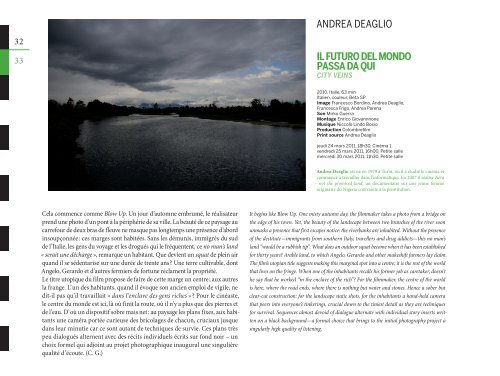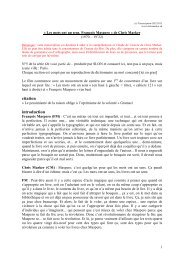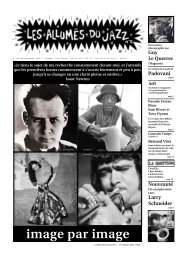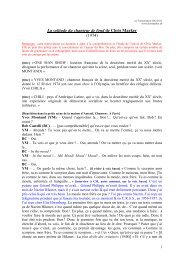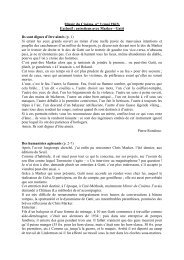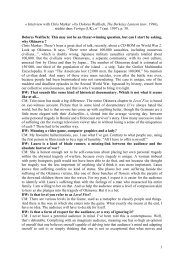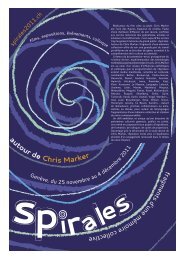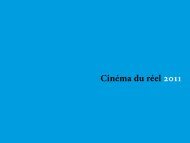3233Andrea DeaglioIl Futuro del mondopassa da quiCity Veins2010, Italie, 63 minItalien, couleur, Beta SPImage Francesco Bordino, Andrea Deaglio,Francesca Frigo, Andrea ParenaSon Mirko GuerraMontage Enrico GiovannnoneMusique Niccolò Lindo BosioPro<strong>du</strong>ction ColombrefilmPrint source Andrea Deagliojeudi 24 mars <strong>2011</strong>, 18h30, Cinéma 1vendredi 25 mars <strong>2011</strong>, 16h00, Petite sallemercredi 30 mars <strong>2011</strong>, 11h30, Petite salleAndrea Deaglio est né en 1979 à Turin, où il a étudié le cinéma etcommencé à travailler dans l’informatique. En 2007 il réalise Nera– not the promised land, un documentaire sur une jeune femmeoriginaire <strong>du</strong> Nigeria contrainte à la prostitution.Cela commence comme Blow Up. Un jour d’automne embrumé, le réalisateurprend une photo d’un pont à la périphérie de sa ville. La beauté de ce paysage aucarrefour de deux bras de fleuve ne masque pas longtemps une présence d’abordinsoupçonnée : ces marges sont habitées. Sans les démunis, immigrés <strong>du</strong> sudde l’Italie, les gens <strong>du</strong> voyage et les drogués qui le fréquentent, ce no man’s land« serait une décharge », remarque un habitant. Que devient un squat de plein airquand il se sédentarise sur une <strong>du</strong>rée de trente ans ? Une terre cultivable, dontAngelo, Gerardo et d’autres fermiers de fortune réclament la propriété.Le titre utopique <strong>du</strong> film propose de faire de cette marge un centre ; aux autresla frange. L’ un des habitants, quand il évoque son ancien emploi de vigile, nedit-il pas qu’il travaillait « dans l’enclave des gens riches » ? Pour le cinéaste,le centre <strong>du</strong> monde est ici, là où finit la route, où il n’y a plus que des pierres etde l’eau. D’ où un dispositif sobre mais net : au paysage les plans fixes, aux habitantsune caméra portée curieuse des bricolages de chacun, cruciaux jusquedans leur minutie car ce sont autant de techniques de survie. Ces plans trèspeu dialogués alternent avec des récits indivi<strong>du</strong>els écrits sur fond noir – unchoix formel qui adjoint au projet photographique inaugural une singulièrequalité d’écoute. (C. G.)It begins like Blow Up. One misty autumn day, the filmmaker takes a photo from a bridge onthe edge of his town. Yet, the beauty of the landscape between two branches of the river soonunmasks a presence that first escapes notice: the riverbanks are inhabited. Without the presenceof the destitute—immigrants from southern Italy, travellers and drug addicts—this no man’sland “would be a rubbish tip”. What does an outdoor squat become when it has been establishedfor thirty years? Arable land, to which Angelo, Gerardo and other makeshift farmers lay claim.The film’s utopian title suggests making this marginal spot into a centre; it is the rest of the worldthat lives on the fringe. When one of the inhabitants recalls his former job as caretaker, doesn’the say that he worked “in the enclave of the rich”? For the filmmaker, the centre of the worldis here, where the road ends, where there is nothing but water and stones. Hence a sober butclear-cut construction: for the landscape static shots, for the inhabitants a hand-held camerathat peers into everyone’s tinkerings, crucial down to the tiniest detail as they are techniquesfor survival. Sequences almost devoid of dialogue alternate with indivi<strong>du</strong>al story inserts writtenon a black background—a formal choice that brings to the initial photography project asingularly high quality of listening.
Bettina BüttnerKinderKids<strong>2011</strong>, Allemagne, 65 minAllemand, n&b, DigiBetaImage E<strong>du</strong>ard StürmerSon Cornelia BöhmMontage Bettina Büttner, E<strong>du</strong>ard StürmerPro<strong>du</strong>ction University of Arts and Design KarlsruhePrint source Künsterlischer Mitarbeiter Medienkunst-FilmCompétition InternationalePremiers Filmssamedi 26 mars <strong>2011</strong>, 14h00, Petite salledimanche 27 mars <strong>2011</strong>, 13h00, Cinéma 1mercredi 30 mars <strong>2011</strong>, 11h30, Petite salleNée en 1983 dans un petit village de Bavière, Bettina Büttnerétudie d’abord les Beaux-Arts à Nuremberg puis le cinéma àl’Université des Arts et <strong>du</strong> Design de Karlsruhe, où enseignentles cinéastes Thomas Heise et Andrei Ujică. Réalisé entre 2008et <strong>2011</strong>, Kinder est son premier film.Dans un noir et blanc 16 millimètres aussi sobre que beau, Kinder reliedeux foyers. L’ un au sens de « maison d’enfants ». Tommy et Marvin, dixans, conversent sur l’usage comparé <strong>du</strong> M16 et <strong>du</strong> fusil à pompe ; un blondinetde sept ans s’agite dans un lit comme s’il mimait un film pornographique.Dès les premiers plans, la joie cristalline de leurs cris dans la forêtcontredit le préjugé <strong>du</strong> home comme institution fermée.L’ autre foyer, c’est la maison où, plus tard, nous retrouvons Marvin, rentrévivre avec sa mère et sa sœur. Le lieu apparaît au contraire oppressant,avec sa courette étriquée où la mère opulente ceinture des bras son filsquand il fait une colère. A l’évidence, un traumatisme a eu lieu ici. Danssa construction, le film assigne à cet événement gravissime une place juste.L’ acte n’a pas empêché les enfants de continuer à jouer, mais il a, on le comprend,contaminé leurs jeux, qu’il nous fait désormais regarder autrement.Le titre – enfants – prend alors le sens d’un âge tendre qui aurait dû êtreépargné. Au souvenir qui ne passe pas, les coups de feu de Marvin et de sasœur en cow-boys sont de bien maigres répliques – <strong>du</strong> gros sel sur la plaie.Attentive, la cinéaste parvient à saisir des images qui métaphorisent celles,invisibles, <strong>du</strong> traumatisme. Mais elle montre aussi Marvin suer à grossesgouttes pour se construire un abri à l’ombre, une cabane où réfléchir.Kinder, ou l’histoire de deux foyers et d’un nid. (C. G.)In 16-mm black and white, as sober as it is beautiful, Kinder links up two homes. One ofwhich is a “children’s home”. There, ten-year-old Tommy and Marvin discuss the use of aM16 compared to a shotgun; a blond seven-year-old moves in his bed as if miming a pornfilm. From the first shots, the sparkling joy of their shouts in the forest contradicts any preconceptionof the “Home” as a closed institution.The other home is the house where later we’ll find Marvin, who has returned to live withhis mother and sister. Here, on the contrary, all seems oppressive, with the hemmed-in yardwhere the son’s tantrums are strapped down by the arms of his corpulent mother. Clearly, atraumatic event happened here. In its structure, the film assigns an appropriate place to thisserious event. It has not stopped the children playing but, as we come to understand, it haspoisoned their games, which we now see in a different light. The title—Children—comes tomean a tender age that should have been spared. The cowboy gunfire of Marvin and his sisterare an all too meagre response to a memory that has not disappeared—the salt in the wound.Attentive, the filmmaker captures images that are metaphors for the trauma’s invisible images.But she also shows Marvin dripping with sweat as he builds a shelter in the shade, a denwhere he can think. Kinder, or the story of two homes and one nest.
- Page 3 and 4: Cinéma du réelremercie toutpartic
- Page 5 and 6: Patrick BazinDirecteur de la BpiBib
- Page 7 and 8: Guy SeligmannPrésident de laScamSo
- Page 9 and 10: Claude LemeslePrésident duConseild
- Page 13 and 14: Autres jurys13Le Jury des jeunes, c
- Page 15 and 16: Compétition internationaleCompéti
- Page 17 and 18: Ruth BeckermannAmerican Passages17C
- Page 19 and 20: Claudio PazienzaExercices de dispar
- Page 21: Lee Anne SchmittThe Last Buffalo Hu
- Page 24: 2425Ariane DoubletLa Pluie et le be
- Page 30: 3031Olga MaurinaDomHome2011, Russie
- Page 35 and 36: Filipa ReisJoão Miller GuerraNuno
- Page 37 and 38: Marco SantarelliScuolaMediaJunior H
- Page 39 and 40: Michele PennettaI Cani abbaianoThe
- Page 41 and 42: juan Manuel SepúlvedaExtraño rumo
- Page 43 and 44: Javier LoarteMe llamoRoberto Delgad
- Page 45 and 46: Vania AillonLa Terre tremble2011, S
- Page 47: Mehdi BenallalAux rêveurstous les
- Page 50 and 51: Matthieu ChatellierDoux amer5051201
- Page 53 and 54: Gaël LépingleJulien2010, France,
- Page 55 and 56: Sophie BruneauMarc-Antoine RoudilMa
- Page 57 and 58: Marie DumoraLa Place2011, France, 1
- Page 60: News From…Patrick KeillerNicolás
- Page 63 and 64: Verena Paravel, J.P. Sniadeckisamed
- Page 65 and 66: 2010, Chine, 356 minMandarin, coule
- Page 67 and 68: Séancesspéciales10. Mythologie ou
- Page 69 and 70: Andrei Ujică,La révolution, live1
- Page 71 and 72: 2010, Roumanie, 180 minRoumain, cou
- Page 73 and 74: 1993, États-Unis /Italie, 55 minHi
- Page 75 and 76: Leo HurwitzAmerica never was Americ
- Page 77 and 78: Leo Hurwitz #1samedi 26 mars 2011,
- Page 79 and 80: Leo Hurwitz #3jeudi 31 mars 2011, 1
- Page 81 and 82:
Richard LeacockRichard Leacock aura
- Page 83 and 84:
Dédicace Richard Leacocksamedi 2 a
- Page 85 and 86:
Les outils du cinéma documentaire
- Page 87 and 88:
Camera #3 Pierre Lhomme, Renato Ber
- Page 89 and 90:
Dédicaces& Ateliers
- Page 91 and 92:
Le poème documentaireLe 28 octobre
- Page 93 and 94:
Exploring documentary #2 Rudy Burck
- Page 96 and 97:
Exploring documentary # 5 Helga Fan
- Page 98 and 99:
Exploring documentary #7 Leighton P
- Page 100 and 101:
Exploring documentary #9 Odes ciné
- Page 103 and 104:
1994 et 2001, France, 8 minFrançai
- Page 105 and 106:
Thanks for the American dream,To vu
- Page 107 and 108:
1931, États-Unis, 11 minCartons an
- Page 109 and 110:
1935, États-Unis, 6 minCartons ang
- Page 112 and 113:
Réalisateur inconnuProtestExtrait
- Page 116 and 117:
Écoute Voir !Hors scèneAvec le so
- Page 118 and 119:
Hors scène #2jeudi 31 mars 2011, 1
- Page 120:
Hors scène #5samedi 2 avril 2011,
- Page 123 and 124:
Hors scène #10dimanche 3 avril 201
- Page 125 and 126:
Lech Kowalski : Underground Rock St
- Page 127 and 128:
Le cinéma est parfois invisible.Ce
- Page 129 and 130:
Adriano Aprà Historien du cinéma,
- Page 131 and 132:
Était-ce un téléfilm ? Un oubli
- Page 133 and 134:
¹de connaître les films du Hollan
- Page 135 and 136:
Freddy BuacheAncien conservateur de
- Page 137 and 138:
¹Vincent Dieutre CinéasteLe film
- Page 139 and 140:
¹c’était une manière de miracl
- Page 141 and 142:
Mon film et l’entretien ont été
- Page 143 and 144:
¹au paysage urbain de New York, le
- Page 145 and 146:
¹Eric Le Roy Chef du service Accè
- Page 147 and 148:
¹Marcel Lozinski CinéasteA la rec
- Page 149 and 150:
¹surgissent quand on les a cherch
- Page 151 and 152:
¹contenu réaliste, voire ethnogra
- Page 153 and 154:
¹Errere errera…Je suis en voyage
- Page 155 and 156:
¹teur, je suis presque sûr que se
- Page 158 and 159:
158159Peter von Bagh Cinéaste, his
- Page 160 and 161:
Mémoire du réel
- Page 162 and 163:
Les 20 ans du Prix Louis Marcorelle
- Page 164 and 165:
Rencontres et événements
- Page 166 and 167:
Soirée Video et Après / Cinéma d
- Page 168 and 169:
Rencontres et débats168169Rencontr
- Page 170 and 171:
Forum AddocQuand le documentairereg
- Page 172 and 173:
172173Séances hors les mursCENTRE
- Page 174 and 175:
176177Index des réalisateursAAbi S
- Page 176 and 177:
178KGP Kranzelbinder GabrieleProduc
- Page 178:
180181L’ équipe du Cinéma du r


